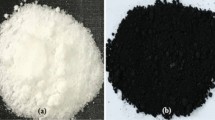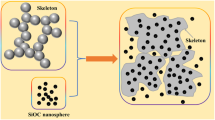Abstract
In order to compare the various precursors of silica aerogels, three different precursors namely TMOS, TEOS and Na2SiO3 were studied in this paper. The property differences of the aerogels caused by the three precursors were discussed in terms of reaction process, gelation time, pore size distributions, thermal conductivity, SEM, hydrophobicity and thermal stability. It has been found that the gelation time of the silica gel is strongly dependent on the type of precursor used. During the surface modification process, organic groups were attached to the wet gel skeletons transforming the hydrophilic to the hydrophobic which were characterized by Fourier Transform Infrared spectroscopy (FTIR). It has been found that the contact angle of the Na2SiO3 and TMOS precursor based aerogels with water have the higher contact angle of 149° and whereas Na2SiO3 precursor based aerogel has the lower contact angle of 130°. The thermal conductivities of the Na2SiO3 and TMOS based aerogels have been found to be lower (0.025 and 0.030 W m−1 K−1, respectively) compared to the TEOS based (0.050 W m−1 K−1) aerogels. The pore sizes obtained from the N2 adsorption measurements varied from 40 to 180, 70 to 190, and 90 to 200 nm for the TEOS, TMOS and Na2SiO3 precursor based aerogels, respectively. The scanning electron microscopy studies of the aerogels indicated that the Na2SiO3 and TMOS based aerogels show narrow and uniform pores while the particles of SiO2 network are very small. On the other hand, TEOS aerogel show non-uniform pores such that the numbers of smaller size pores are less compared to the pores of larger size while the SiO2 particles of the network are larger as compared to both Na2SiO3 and TMOS aerogels. Hence, the surface are of the aerogels prepared using TEOS precursor has been found to be the lowest (~620 m2 g−1) compared to the Na2SiO3 (~868 m2 g−1) and TMOS (~764 m2 g−1) aerogels.








Similar content being viewed by others
References
C.A.M. Mulder et al., in Aerogels, ed. by J. Fricke (Springer, Berlin, 1986), p. 68
T. Burger, J. Fricke, Aerogels: production, modification and applications. Ber. Bunsenges. 102, 1523–1528 (1998)
J. Gross, J. Fricke, Ultrasonic velocity measurements in silica, carbon and organic aerogels. J. Non Cryst. Solids 145, 217–222 (1992)
E. Cuce, P.M. Cuce, C.J. Wood, S.B. Riffat, Toward aerogel based thermal superinsulation in buildings: a comprehensive review. Renew. Sustain. Energy Rev. 34, 273–299 (2014)
M.M. Koebel, A. Rigacci, P. Achard, Aerogel-based thermal superinsulation: an overview. J. Sol-Gel. Sci. Technol. 63, 315–339 (2012)
J.G. Reynolds, P.R. Coronado, L.W. Hrubesh, Hydrophobic aerogels for oil-spill cleanup—synthesis and characterization. J. Non Cryst. Solids 292(1–3), 127–137 (2001)
I. Smirnova, S. Suttiruengwong, W. Arlt, Feasibility study of hydrophilic and hydrophobic silica aerogels as drug delivery systems. J. Non Cryst. Solids 350(2004), 54–60 (2004)
G.M. Pajonk, S.J. Teichner, J. Fricke (eds.), Aerogels (Springer, NewYork, 1986), pp. 193–199
G.M. Pajonk, Aerogel catalysts. Appl. Catal. 72, 217–266 (1991)
J. Fricke, A. Emmerling, Aerogels—recent progress in production techniques and novel applications. J. Sol-Gel. Sci. Technol. 13(1–3), 299–303 (1999)
U.K.H. Bangi, A.V. Rao, A.P. Rao, A new route for preparation of sodium silicate-based hydrophobic silica aerogels via ambient-pressure drying. Sci. Technol. Adv. Mater. 9, 035006 (2008)
L.-J. Wang, S.-Y. Zhao, M. Yang, Structural characteristics and thermal conductivity of ambient pressure dried silica aerogels with one-step solvent exchange/surface modification. Mater. Chem. Phys. 113, 485–490 (2009)
Hajar Maleki, Luisa Duraes, Antonio Portugal, Development of mechanically strong ambient pressure dried silica aerogels with optimized properties. J. Phys. Chem. C 119, 7689–7703 (2015)
D.B. Mahadik, A.V. Rao, P.B. Wagh, S.C. Gupta, Synthesis of transparent and hydrophobic TMOS based silica aerogels. AIP Conf. Proc. 1536, 553 (2013)
Wim J. Malfait, Shanyu Zhao, Rene Verel, Subramaniam Iswar, Daniel Rentsch, Resul Fener, Yucheng Zhang, Barbara Milow, Matthias M. Koebel, Surface chemistry of hydrophobic silica aerogels. Chem. Mater. 27(19), 6737–6745 (2015)
S. Hea, Z. Lia, X. Shia, H. Yanga, L. Gonga, X. Cheng, Rapid synthesis of sodium silicate based hydrophobic silica aerogel granules with large surface area. Adv. Powder Technol. 26(2), 537–541 (2015)
P.B. Wagh, R. Begag, G.M. Pajonk, A.V. Rao, D. Haranath, Comparison of some physical properties of silica aerogel monoliths synthesized by different precursors. Mater. Chem. Phys. 57, 214–218 (1999)
D.B. Mahadik, A.V. Rao, The ambient pressure dried TEOS based silica aerogel granules. J. Porous Mater. 19(1), 87–94 (2012)
P.B. Sarawade, J.-K. Kim, A. Hilonga, D.V. Quang, H.T. Kim, Synthesis of hydrophilic and hydrophobic xerogels with superior properties using sodium silicate. Microporous Mesoporous Mater. 139, 138–147 (2011)
G.W. Scherer, R.M. Swiatek, Measurement of permeability: II. Silica gel. J. Non Cryst. Solids 113(2–3), 119–129 (1990)
E. Nilsen, M.-A. Einarsrud, G.W. Scherer, J. Non Cryst. Solids 221, 135 (1997)
D.M. Smith, G.W. Scherer, J.M. Anderson, J. Non Cryst Solids 188, 191 (1995)
A.E. Scheidegger, The Physics of Flow Through Porous Media, 3rd edn. (University of Torento Press, Torento, 1974)
P.M. Adler, Transport processes in fractals. VI. Stokes flow through Sierpinski carpets. Phys. Fluids 29, 15 (1986)
F. Rojas, I. Kornhauser, C. Felipe, J.M. Esparza, S. Cordero, A. Dom-ínguez, J.L. Riccardo, PCCP Phys. Chem. Chem. Phys. 22, 2346–2355 (2002)
S.A. Lermontov, A.N. Malkova, L.L. Yurkova, E.A. Straumal, N.N. Gubanova, A.Y. Baranchikov, V.K. Ivanov, Mater. Lett. 116, 116–119 (2014)
D.B. Mahadik, Y.K. Lee, N.K. Chavan, S.A. Mahadik, H.-H. Park, Monolithic and shrinkage-free hydrophobic silica aerogels via new rapid supercritical extraction process. J. Supercrit. Fluids 107, 84–91 (2016)
U. Schubert, N. Hüsing, Synthesis of inorganic materials (Wiley-VCH, Weinheim, 2005), pp. 92–221
Acknowledgments
The corresponding author is highly thankful to the UGC, New Delhi, India, for the funding this work under University Grant Commission-Basic Science Research (UGC-BSR) Faculty Fellowship No. F.18-1/2011 (BSR). One of the authors, Abhijit A. Pisal is highly grateful to the UGC, New Delhi, for the Stipendiary Candidateship under UGC-BSR-Faculty Fellowship.
Author information
Authors and Affiliations
Corresponding author
Rights and permissions
About this article
Cite this article
Pisal, A.A., Rao, A.V. Comparative studies on the physical properties of TEOS, TMOS and Na2SiO3 based silica aerogels by ambient pressure drying method. J Porous Mater 23, 1547–1556 (2016). https://doi.org/10.1007/s10934-016-0215-y
Published:
Issue Date:
DOI: https://doi.org/10.1007/s10934-016-0215-y




